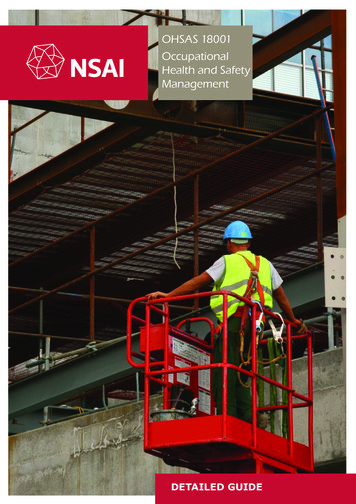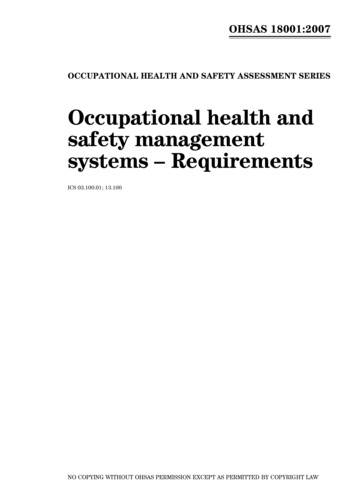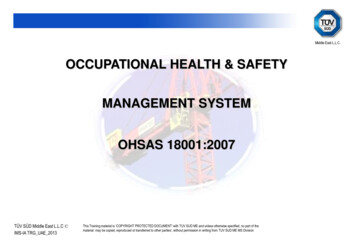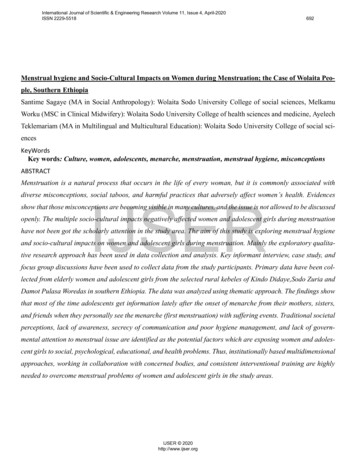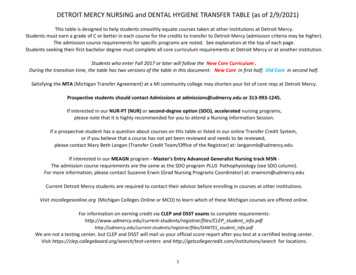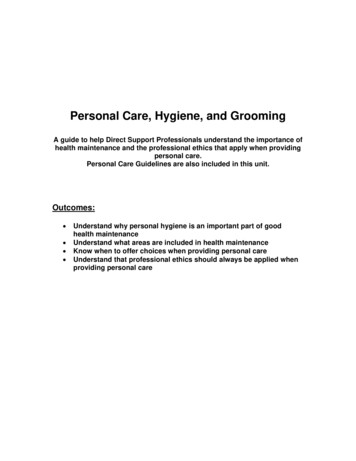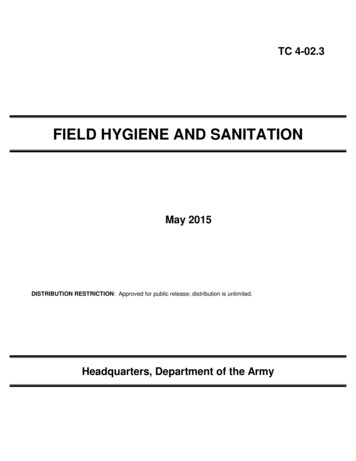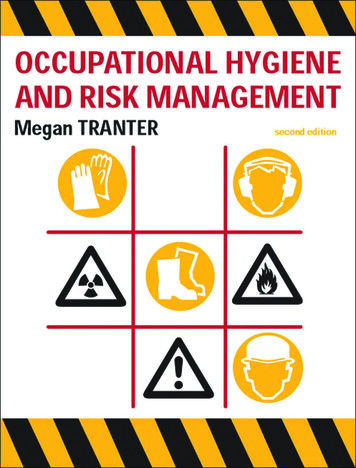
Transcription
OCCUPATIONAL HYGIENEAND RISK MANAGEMENT
OCCUPATIONAL HYGIENEAND RISK MANAGEMENTSecond editionMEGAN TRANTER
This edition first published in Australia in 2004 Megan Tranter 2004The material in this book is intended for reference only. The author and publisher expresslydisclaim all liability to any person arising directly or indirectly from the use of, or from anyerrors or omissions in the content of this book.All rights reserved. No part of this book may be reproduced or transmitted in any form or byany means, electronic or mechanical, including photocopying, recording or by anyinformation storage or retrieval system, without prior permission in writing from thepublisher. The Australian Copyright Act 1968 (the Act) allows a maximum of one chapter or10% of this book, whichever is the greater, to be photocopied by any educational institutionfor its educational purposes provided that the educational institution (or body thatadministers it) has given a remuneration notice to Copyright Agency Limited (CAL)under the Act.Allen & Unwin83 Alexander StreetCrows Nest NSW 2065Phone:Fax:Email:Web:(61 2) 8425 0100(61 2) 9906 ional Library of AustraliaCataloguing-in-Publication entry:Tranter, Megan.Occupational hygiene and risk management.Bibliography.Includes index.ISBN 1 74114 329 2.1. Industrial hygiene. 2. Risk management. I. Title.613.62Index: Russell BrooksTypeset in 10/12pt Amerigo by Asset Typesetting Pty Ltd.Printed by Southwood Press, Sydney.10 9 8 7 6 5 4 3 2 1
CONTENTSChapter 1 Fundamentals of occupationalhygiene and risk management1Occupational hygieneRisk managementRisk perceptionStates of matterToxicologyRoutes of entryDistribution, metabolism and excretionDoseCarcinogenicityChronic versus acute exposureNational exposure standardsSampling and measurementTypes of national exposure standardsUnits of measurementBiological exposure indicesEpidemiologyRisk factorsSummaryBibliography and further reading12348910111315161818202425272829Chapter 2 Working out the human body31Our bodily systemsCardiovascular systemDigestive systemEndocrine systemImmune system3133343637
vi Occupational Hygiene and Risk ManagementIntegumentary systemLymphatic systemMuscular systemNervous systemReproductive systemRespiratory systemSkeletal systemUrinary systemAnatomical positionsSummaryBibliography and further readingChapter 3 Hazard identificationInspectionsOccupational hygiene auditingUsing information or specialist adviceReviewing records — material safety data sheetsReviewing records — labellingSummaryBibliography and further readingChapter 4 Dusts and particulateDust exposure in industry — a historical reviewDefinitionsDustsSize distributions of dustsRespirable dust monitoringInspirable dust monitoringTotal dust monitoringParticle size and dust characterisation monitoringDirect-reading monitoring equipmentDusts of occupational hygiene significanceFibresSummaryBibliography and further 86871757980808181889797
ContentsChapter 5 MetalsThe toxicity of metalsNature of contaminant and routes of entrySpecific metals and their risksSummaryBibliography and further readingChapter 6 Chemical contaminantsThe nature of gases and vapoursPhysiological effects of exposure to gasesSimple asphyxiantsDetermining oxygen displacement from simple asphyxiantsChemical asphyxiantsIrritant gasesSolventsOther chemical contaminants of occupational hygiene significanceConfined spacesOccupational hygiene monitoring techniquesDirect monitoringSample collection and analysisBiological monitoringSummaryBibliography and further readingChapter 7 Noise and vibrationThe physics of soundCharacteristics of soundwavesCharacteristics of soundEmission and immissionThe logarithmic response to soundHow the ear hearsEffects of exposure to noiseSound pressure levels, weightings and noise doseMeasuring noiseConducting a noise survey 49150154158159159161162163164165165166168170174178
viii Occupational Hygiene and Risk ManagementOccupational noise managementControlling noise transmissionAudiometric testingHearing protection devicesSelecting hearing protection devicesVibrationHealth effects of exposure to vibrationMeasuring vibrationControlling vibration exposureSummaryBibliography and further readingChapter 8 Heat and coldThermoregulation: Maintaining the body’s equilibriumThe effects of exposure to excessive heatPhysiological monitoring of exposure to heatThe effect of metabolic work rateEnvironmental monitoring of exposure to heatHeat stress indicesControls for heatExposure to cold and moderately cold environmentsSummaryBibliography and further 06208208212218220222222Chapter 9 Radiation and pressure225Ionising radiationInstrumentationNon-ionising radiationControls for radiationPressureSummaryBibliography and further reading225230232239239240240
ContentsChapter 10 Biological hazardsHuman and microbial interactionCategories of biological agentsBacterial zoonosesChlamydioses and rickettsiosesVirusesParasitic diseaseFungiHumans as reservoirsIndoor air qualityOrganic dustsHigh-risk industriesMonitoring techniques and countingControls for biological hazardsSummaryBibliography and further readingChapter 11 ErgonomicsSome definitions of ergonomicsMuscular workBiomechanicsManual materials handlingAnthropometryStressShift work and working hoursLightingSummaryBibliography and further readingChapter 12 Risk analysisRisk and hazardDanger and safetyDefinition of risk analysisConducting a risk assessmentRisk perception 2
x Occupational Hygiene and Risk ManagementBias and risk perceptionRisk communicationSummaryBibliography and further readingChapter 13 ControlThe aims of controlTaking a methodical approach to controlMethods of controlHierarchy of controlVentilationDilution ventilationLocal exhaust ventilationPersonal protective equipmentSummaryBibliography and further readingChapter 14 Using a systematic approach to risk 26326329Managing and managementTheories of managementReasons for managing occupational hygiene risksManaging and motivating peopleManagement systemsSummaryBibliography and further reading329329330333335339340Index341
LIST OF ABBREVIATIONSAASACACGIHADG Catomic absorption spectroscopyasbestos-cementAmerican Conference of Governmental Industrial HygienistsAustralian Dangerous Goods Codeaerodynamic equivalent diameteratomic emission spectroscopyallowable exposure timeas low as reasonably achievableanti-vibration mountingsBritish Cast Iron Research Associationbiological exposure indexBritish Medical Research Councilchromated copper arsenatecorrected effective temperaturechlorinated fluorocarboncentral nervous systemcumulative trauma disordercarpal tunnel syndromedry bulbdeoxyribonucleic aciddaily noise dosedispersion stainingequivalent chill temperatureelectromagnetic radiationeffective temperatureenvironmental tobacco smokefibrous aerosol monitorgas chromatographglobe temperaturehigh efficiency particulatehexamethylene diisocyanateHealth and Safety Executive [UK]heat stress indexheating, ventilation and airconditioningInternational Agency for Research on Cancer
xii Occupational Hygiene and Risk AMRBCRCFRELinductively coupled plasmaintensity levelinfraredInternational Standards Organisationlethal concentrationlethal doselower explosive limitlocal exhaust ventilationlifting indexlumbosacral compressive forcesmixed cellulose estermedium density fibreboardmethylene bisphenyl isocyanatemanual materials handlingman-made mineral fibresman-made vitreous fibresmass spectroscopymaterial safety data sheetNational Association of Testing Authoritiesnational exposure standardsNational Health and Medical Research CouncilNational Institute of Occupational Safety and Health [US]National Occupational Health and Safety Commissionnormal temperature and pressurenatural wet bulboccupational exposure limits [UK]occupational health and safety management systemOccupational Safety and Health Authority [US]predicted 4-hour sweat ratepolycyclic aromatic hydrocarbonpowered air-purifying respiratorpeak expiratory flow ratepermissible exposure limitspolarising light microscopyprogressive massive fibrosispartial noise doseperipheral nervous systempersonal protective equipmentpersonal sound exposure meterp-tert-butylphenolpermanent threshold shiftpolyvinyl chloridereal-time aerosol monitorred blood cellrefractory ceramic fibrerecommended exposure limit
List of WBGTWRULDXRDradio frequencyrelative humidityregulatory impact statementrequired minimum protection factorrespiratory protection equipmentrepetitive strain injuryradiant temperaturerapid upper limb assessmentrecommended weight limitsick building syndromeInternational System of UnitsSafety in Mines Research Establishmentsound level metersynthetic mineral fibrestandard mortality ratestandard operating proceduresound pressure levelshort-term exposure limitstandard temperature and pressurestrengths, weaknesses, opportunities and threatstoluene 2,4 diisocyanatethermoluminescent dosimetertemporary threshold shifttime-weighted averageultravioletvideo recording analysisvolatile organic compoundwet bulbwet bulb globe temperaturework-related upper limb disorderX-ray diffractometry xiii
Chapter 1Fundamentals of occupationalhygiene and risk managementAs awareness of the importance of minimisingoccupational health and safety risk continues togrow amongst Australian employers, so toodoes the science of occupational hygiene.Occupational hygiene hazards such as dusts,noise, chemicals, vibration, radiation, ergonomics, light, pressure and biological agentsrequire an especially diligent approach toensure they are not only identified, but the levelof risk assessed and appropriate controls put inplace for the long-term health of workers.Unfortunately, history shows situations whereoccupational hygiene risks have not been wellmanaged: for instance, exposure to crocidolite(blue) asbestos during mining operations inWestern Australia resulting in death frommesothelioma, a highly aggressive cancer of thelung pleura, is not expected to peak for anothertwo decades. What about the effects ofstonemasons’ exposure to crystalline silica,excessive noise at concerts, vibration in heavyvehicles or exposure to mercury from brokenthermometers in hospitals or formaldehyde innewly refurbished office buildings?This chapter will define the term occupational hygiene, the principles of riskmanagement and the difference between hazardand risk. It will also provide an introduction totoxicology, the concept of dose, exposure andepidemiology. Occupational exposure standardsand biological exposure indices will be explainedand their uses shown with some practicalexamples.OCCUPATIONAL HYGIENEFor a long time, we have known that work canaffect our health. In 1775 Percivall Pott, asurgeon at St Bartholemew’s Hospital, described the occurrence of scrotal cancer inchimney sweeps. It was only later that polycyclic aromatic hydrocarbons (PAH) were identified as the cause. Manufacturing of matcheswith phosphorous was linked to necrosis of thejaw, felting of animal fur with organic mercurycaused neurological changes, use of vinylchloride monomer in the manufacture ofpolyvinyl chloride (PVC) caused liver cancer, andbenzene from the petroleum refining industrywas linked with leukaemia. Studies into theeffects of electromagnetic radiation fromwireless technologies such as mobile telephones continue to draw mixed conclusions.Occupational hygiene is aimed at reducingthe probability that workers’ health will beaffected by work. The term ‘health’ is verybroad. It not only considers physical health butalso our psychological and emotional wellbeing. For instance, exposure to nickel maycause dermatitis of the skin, which by itself isnot life threatening. However, a noticeable rashmay lead to a sense of isolation from thecommunity and cause psychological scarring asthe worker attempts to escape ridicule ormisunderstanding about their condition.Occupational hygiene can be thought of as theidentification, evaluation and control of agents
2 Occupational Hygiene and Risk ManagementCase study 1: Identification, evaluation and controlSeveral workers in a restaurant have reported headaches and feeling drowsy whenthey serve customers through a driveway window. The serving window is closedwhen customers have been served and they have driven away. The building isairconditioned.The occupational hygiene hazard was identified as the gas carbon monoxide(CO), a chemical asphyxiant which is released from motor vehicles. The exposurewas evaluated and the ventilation adjusted to reduce exposure.that can harm a worker’s health. These agentscan exist in a number of forms: biological,chemical, ergonomic, physical. Physical hazardscan include light, noise, pressure, radiation andvibration. Chemical hazards may be in the formof aerosols, dusts, fibres, fume, gas, mists,smoke or vapours. Bacteria, fungi, protozoanand viruses are examples of biological agents.Shift work, manual handling and occupationalstress are considered to be ergonomic hazards.RISK MANAGEMENTEffective identification, evaluation and controlcan manage occupational hygiene hazards.These are also known as the principles of riskmanagement. Identification or recognition of theagent requires knowledge of the workplace andits processes, materials, by-products and outputs. Some practical methods that might assistin correct identification include conducting awalk-through survey of the conditions of theworkplace, review of information such as labelsor material safety data sheets and discussionwith workers. The evaluation stage will considerthe probability that exposure will cause harmand the magnitude of this effect. This is alsoknown as assessment or risk assessment. Implementation of controls may depend upon thenature of the agent, cost, feasibility and theresults of the evaluation. Once steps have beentaken to control exposure, the effectiveness ofsuch interventions should be reviewed.Following these principles is crucial to theoccupational hygiene process. Incorrectidentification of the nature or type of occupational hygiene hazards will result in time andresources being spent investigating aspectsthat may not in fact require it. Equally, if theagent is not evaluated against valid criteria, thepotential outcome will not be recognised andcontrols may not be sufficient to protect theworker. More details about hazard identification techniques are discused in Chapter 3.Strategies for managing risk are included inChapter 14.Hazard and RiskThe terms hazard and risk are often usedsynonymously, although their meanings arequite separate. Hazard is defined inAS/NZS4360: 1999 as a source or situation withpotential for harm in terms of human injury orill health, damage to property, environment, ora combination of these. In other words, hazardrelates to a possibility. Risk, on the other hand,is the likelihood or probability that the hazardwill cause damage or harm. The degree or themagnitude of the risk is determined by theduration of exposure, most likely outcomefrom exposure and the frequency of exposure.For instance, a bath containing hydrochloric acid (used for etching metal) may behazardous but only presents a risk to workersif they are working nearby and could beexposed to the acid and sustain an injury.
Chapter 1: Fundamentals of occupational hygiene and risk managementAsbestos fibres, which are firmly embedded ina matrix such as asbestos-cement sheeting(found on roofs from the 1950s), can behazardous. However, a risk will only exist if thefibres are released from the matrix, becomeairborne and are inhaled. This may occur if theroof is cleaned using a high-pressure waterspray or if the roof is broken.Hazard potential that an eventsequence will causedamage or harmRisk likelihood that an eventsequence will causedamage or harm. Thecombination offrequency, duration andseverity of exposure.The concept of risk assessment lies core toAustralia’s occupational health and safetylegislative framework. This extends to occupational hygiene hazards with some States prescribing the conduct of mandatory risk assessments for specific hazards such as manualhandling and chemicals. While risk per se can beassessed using a number of methods, it is important to identify the assumptions andlimitations that go with the process. Quantitative risk assessments of occupational hygienehazards generally involve measuring exposureand comparison against a scientifically validatedbenchmark. Consideration is made of the natureof the hazard, the cycle or pattern of exposureand knowledge about the acute and chronichealth effects of the agent. Due to the complexissues associated with interpretation of data,these types of risk assessments are bestperformed by qualified and experienced occupational hygienists. Misinterpretation of exposure results is a serious issue with both legalramifications for an employer managing risk andpotentially compromising workers’ health.Qualitative risk assessment is made byevaluating the three components of risk andthe most likely event sequence. For instance,the frequency of exposure may be judged as‘rare’ or ‘occasional’. The duration of exposuremay range from ‘constant’ to ‘less than onceeach day’. Severity of outcome can bemeasured by magnitude, such as ‘death’ or‘minor injuries’.Risk management as a profession incorporates many sources of loss. In order foran organisation to manage the potentiallosses, a philosophy of recognition, evaluationand control is promoted. However, dependingupon a person’s experiences and beliefs, theymay approach the task in different ways. Thiscould be due to their perception of risk.RISK PERCEPTIONThe final decision about the level of risk in theworkplace will vary depending upon perceptions. Risk perception is an individual’s interpretation of the level of risk associated with anevent and their tolerance to this risk. Riskperception will be discussed further in Chapter14 and it is influenced by factors such as: self-control over the risk versusimposed risk natural versus human-made risk familiarity with the risk understanding of the effects ofexposure to the risk financial or other gain to be madefrom exposure to the risk cultural norms, beliefs and values society’s acceptance of risks.Some industries such as undergroundcoalmining traditionally provided workers witha financial incentive to work in particularlyhigh-risk places. Extra payment was given forworking in noisy or dusty environments. Eventoday, with ever-improving standards of healthand safety at work, it is clear that a worker’sperception of risk can be influenced by thefactors identified above. Risks may be 3
Occupational Hygiene and Risk ManagementCase study 2: Risk perceptionA worker at a construction site is conscious of the high levels of noise at theworkplace. He stringently observes signage requiring that hearing protectiondevices be worn in designated areas and coaches other people that visit the sitewithout wearing earplugs. At the end of a busy week, he unwinds at his local club.After leaving the club he notices that his hearing feels a little ‘dull’ and experiencesa buzzing sound in his ears that lasts for several hours. While he acknowledges thatthe noise levels at the club may be high, he is willing to accept the exposure as itis his choice and he believes that loud music is the norm at a club.tolerated because of the perceived advantages.While the risk is not unacceptable, a compromise may be reached where the positiveaspects are accepted as outweighing thenegatives.Benefits4 Not tolerableTolerableRiskFigure 1.1Risk toleranceSTATES OF MATTERIn the workplace, hazards can exist in a numberof forms. It is also important to note that asubstance’s state of matter can change during aprocess or naturally. States of matter refers tothe physical and chemical composition andarrangement of atoms (the building blocks of allobjects). It can be described in terms of amicroscopic or macroscopic aspect. Amicroscopic outline refers to the motion of allthe atoms of molecules making up thesubstance. The macroscopic description ofmatter gives us a more practical application andallows us to look at the effect of the substance’spressure, temperature and volume.Atoms are the smallest form of matter, andcontain protons, neutrons and electrons. Whena number of atoms combine together, amolecule is formed. For instance, 1 atom of sodium (Na ) could combine with 1 atom of–chlorine (Cl ) to form 1 molecule of salt (NaCl).These atoms combine by exerting attractiveforces on each other. However, if the moleculesmove too close, the force becomes repulsive asthe outer electrons electrically repulse eachother. Thus the atoms must maintain aminimum distance from each other to maintainthe molecules in a more or less fixed position— a crystal lattice.In a solid, the atoms or molecules arenearly locked into a position with littlemovement, vibrating around this position. In aliquid, the forces between the atoms ormolecules are weaker, allowing them to movemore rapidly and roll over each other. With agas, the atoms or molecules move so freely andcollide into one another that the force ofattraction is not strong enough to keep themclose together, and they fill any space andmove in all directions.Atoms and molecules also have an atomicor molecular mass, respectively. This refers tothe relative mass of the atoms and molecules,
Chapter 1: Fundamentals of occupational hygiene and risk management12compared with an ordinary carbon atom ( C),which is given a value of exactly 12.000 atomicmass units (u). The atomic mass of atoms canbe found in the periodic table of elements. Theperiodic table is shown at the front of thisbook. Some examples of atomic masses areshown in Table 1.1.Table 1.1Examples of atomic massesAtomicnumberElementAtomic mass 8112.01114.006715.999418.9984The molecular mass is determined byadding individual atomic masses. For instance,water (H2O) consists of 2 hydrogen atoms and1 oxygen atom. The atomic mass of hydrogenis about 1.0080 u and the atomic mass ofoxygen is 16.00 u. The molecular mass of 1molecule of water is about 18.016 u.Another important characteristic of atomsis their constant movement, the so-calledBrownian movement. This can be bestexplained as the random movement of tinyparticles within a medium, such as water or air,even though the medium itself appears not tobe moving. Since all atoms are constantlyvibrating and in constant motion, the rapidlymoving molecules of the media jostle the tinyparticles and cause this movement. This concept is particularly important when investigating the movement and deposition of tiny dustparticles (respirable dust) in the human lung,and is discussed in Chapter 2.Example 1.1What is the molecular mass of1 molecule of zinc oxide?Answer:One molecule of zinc oxide consists of1 zinc (Zn) atom and one oxygen (O)atom, forming ZnO. The atomic mass ofzinc is 65.38 u and the atomic mass ofoxygen is 16.00 u. The molecular massof 1 molecule of zinc oxide is therefore65.38 16.00, or 81.38 u.The three main states of matter are: solid gas liquid.Temperature, pressure and volume can alsochange the properties of matter. For instance,a steel beam is longer when heated, concreteexpands and contracts according totemperature, and water can change from solidto liquid as temperature increases.From an occupational hygiene perspective,the main categories of substances that we dealwith are: s or particulate are solid matter, whosechemical composition and size vary. A solid canbe a pure substance such as gold or it can be acompound such as lead oxide (PbO) or acombination of molecules. Solids maintain afixed shape and fixed size, even when a largeforce is applied to the solid. 5
6 Occupational Hygiene and Risk ManagementSome examples of dusts include: wood dust pesticide and herbicide dust alkali dust (e.g. potassiumpermanganate, (KMnO4), used in watertreatment plants) crystalline silica (SiO2) from sandstoneor granite and often found in coalseams.Fume is also solid matter but the matter isheated and is finely divided. Fume is oftenvisible to the naked eye and is typicallygenerated from heating metal (Figure 1.2).Aerosols and mists refer to liquid dropletsthat are suspended in the air. A simplifiedexample of mist is fog. Fog occurs where warmand cold air meet and where the warm moist airblows over a cold surface. This causescondensation of dissolved water in air to form.Some examples of aerosols and mists found inthe workplace include mists from the use ofacid-filled vessels for cleaning metals beforebeing electroplated and mists from pressurepack cleaning aids.GasesSmokeSmoke is a complex mixture of particulate,vapour and gas. The particulate arises fromcombustion of solid material and gases suchas: carbon monoxide (CO) oxides of nitrogen (NOx) carbon dioxide (CO2).The composition of the smoke mixture isconstantly changing between the particulate,vapour and gaseous form.Figure 1.2AerosolsGases consist of a loose matrix of atoms ormolecules that move randomly within a space.Some examples of gases include: oxygen (O2)nitrogen (N2)methane (CH4)helium (He).Since the atoms or molecules move and collidein a space, they can be affected bytemperature, pressure and volume. This isespeciallyimportantwhen assessing theeffect of gases enteringconfined spaces or theimpact of an increase intemperature within aworkplace. It has beenfound that a particularvolume of a gas isinversely proportionalto the pressure applied,where the temperatureremains constant. Thisrelationship is known asBoyle’s Law and isshown in Equation 1.1.Zinc oxide (Zn0) fume from welding galvanised steel
Chapter 1: Fundamentals of occupational hygiene and risk managementEquation 1.1V 1/P (constant T)Therefore, if the pressure on a gas is doubled,its volume is reduced to half the originalvolume. Temperature will also affect thevolume of a gas. Jacques Charles (1746–1823)described the quantitative relationshipbetween volume (V) and temperature (T) morethan a hundred years after Robert Boyle’sdiscovery. Charles identified that the volume ofa gas increases at an almost constant rate,when the pressure is not high and is keptconstant, as the temperature increases.However, all gases liquefy at lowtemperatures. This means that the relationshipbetween temperature and pressure only existsto the lowest temperature that gas can exist at.This value has been measured as –273.15 C,and is known as the absolute zero oftemperature. Absolute zero forms the basis ofthe Kelvin (K) scale, which specifiestemperature as degrees Kelvin (K). To convertbetween degrees Kelvin and degrees Celsius, itis simply a matter of adding 273 to the Celsiusvalue. In other words, 273 K is equal to 0 C.Therefore, if the temperature of an idealgas is increased, the pressure and volume willalso increase (Equation 1.2).(Equation 1.3) the pressure of gas is directlyproportional to the absolute temperature,where the gas is at a constant volume.Equation 1.3P T (constant V)An example of this law in application is a closedtin of highly volatile hazardous substance whichmay explode when left in the sun due to anincrease in the gas pressure inside.The relationship between these variables isdescribed as the ideal gas law and is shown asEquation 1.4. This relationship shows that thecombination of pressure (P) and volume (V) isproportional to temperature (T) and thenumber of moles of gas (n), given a constant ofproportionality (R). R is known as the universal–1–1gas constant (8.315 J.mol .K ) and is constantfor all gases. A mole (mol) is the amount of asubstance that contains as many atoms ormolecules as there are in 0.0012 kg of carbon12 (u 12). In other words, 1 mole is thenumber of grams that are numerically equal tothe molecular mass of the substance. Forinstance, 1 mol nitrogen (N2) has a mass of0.028 kg.Equation 1.4Equation 1.2T V (constant P)Imagine a balloon filled with air and then leftto sit in a car during a hot day. What happens?The balloon walls will stretch as the pressurecaused by the increasing temperature rises.This then results in increasing volume andeventually the balloon walls will stretch nofurther and it explodes.Another law of gas shows the relationshipbetween pressure and temperature, and isknown as Gay-Lussac’s law. In this lawPV nRTWhere:–2)P is pressure (N.m3V is volume (m )T is temperature (K)n is number of moles (mol) of gasR is universal–1 gasconstant–1(8.315 J.mol .K )One final point relates to the terms standardtemperature and pressure (STP) and normaltemperature and pressure (NTP). Mostreferences define STP as standard conditions,which means a temperature of 273 K (0 C) and 7
8 Occupational Hygiene and Risk Management–2pressure of 1 atmosphere (101 325 N.m ). NTPrefers to a temperature of 298 K (25 C) andpressure of 1 atmosphere.VapoursVapours can best be explained as molecules oratoms that escape from the surface of a liquid.As liquid, molecules are attracted to oneanother by strong forces. However, themolecules in the upper section of the liquidmay leave the liquid for a short time.Usually, t
Occupational hygiene and risk management. Bibliography. Includes index. ISBN 1 74114 329 2. 1. Industrial hygiene. 2. Risk management. I. Title. 613.62 Index: Russell Brooks Typeset in 10/12pt Amerigo by Asset Typesetting Pty Ltd. Printed by Southwood Press, Sydney. 10 9

